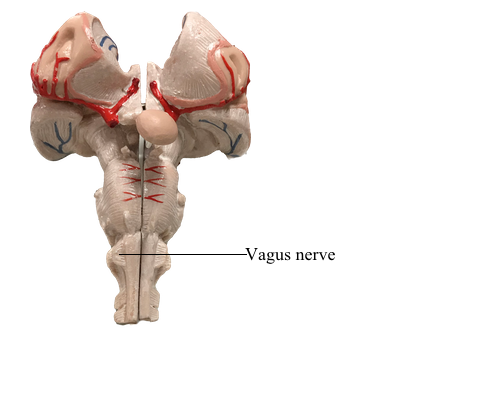Main Model

Cranial Nerves : X Vagus nerve

Vagus Nerve (CN X)
Functions: Sensory - somatic (general) sensory, special sensory (taste), visceral sensory. Motor - somatic (brachial) motor and visceral (parasympathetic) motor.
• Somatic (general) sensory from the inferior pharynx, and larynx.
• Visceral sensory from the thoracic and abdominal organs.
• Taste and somatic (general) sensation from the root of the tongue and taste buds on the epiglottis. Branches of the internal laryngeal nerve (a branch of CN X) supply a small area, mostly somatic (general) sensory, but also some special sensation (taste).
• Somatic (branchial) motor to the soft palate; pharynx; intrinsic laryngeal muscles (phonation); and a nominal extrinsic tongue muscle, the palatoglossus, which is actually a palatine muscle based on its derivation and innervation.
• Proprioceptive to the muscles listed above.
• Visceral (parasympathetic) motor to thoracic and abdominal viscera.
Nuclei: Sensory - sensory nucleus of the trigeminal nerve (somatic sensory) and nuclei of the solitary tract (taste and visceral sensory). Motor - nucleus ambiguus (somatic [branchial] motor) and dorsal vagal nucleus (visceral [parasympathetic] motor).
The vagus nerve (CN X) has the longest course and most extensive distribution of all the cranial nerves, most of which is outside of (inferior to) the head. The term vagus is derived from the Latin word vagary, meaning “wandering”. CN X was so called because of its extensive distribution. It arises by a series of rootlets from the lateral aspect of the medulla that merge and leave the cranium through the jugular foramen positioned between CN IX and CN XI.
What was formerly called the “cranial root of the accessory nerve” is actually a part of CN X. CN X has a superior ganglion in the jugular foramen that is mainly concerned with the general sensory component of the nerve. Inferior to the foramen is an inferior ganglion (nodose ganglion) concerned with the visceral and special sensory components of the nerve. In the region of the superior ganglion are connections to CN IX and the superior cervical (sympathetic) ganglion. CN X continues inferiorly in the carotid sheath to the root of the neck, supplying branches to the palate, pharynx, and larynx.
The courses of the vagi are asymmetrical in the thorax, a consequence of rotation of the midgut during development. CN X supplies branches to the heart, bronchi, and lungs. The vagi form anterior and posterior vagal trunks that are continuations of the esophageal plexus surrounding the esophagus, which is also joined by branches of the sympathetic trunks. The trunks pass with the esophagus through the diaphragm into the abdomen, where the vagal trunks break up into branches that innervate the stomach and intestinal tract as far as the left colic flexure.